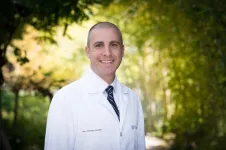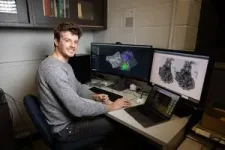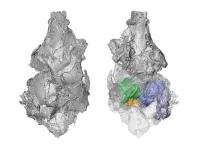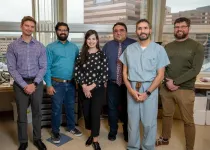(Press-News.org) LOS ANGELES — Physicians at City of Hope, one of the largest cancer research and treatment organizations in the United States, in cooperation with the Children’s Oncology Group (COG), have conducted the largest clinical trial to date seeking to reduce the risk of people who have survived childhood cancer from developing heart failure. The findings published in The Lancet Oncology show that the blood vessel relaxing medication carvedilol is safe for childhood cancer survivors to take and may improve important markers of heart injury sustained as a result of chemotherapy exposure.
One devastating long-term side effect from a class of chemotherapy called anthracycline is increased risk of heart failure where the heart can’t pump enough blood to meet the body’s needs. This is a delayed process where the heart undergoes gradual changes over time characterized by the thinning of the heart muscle and enlargement of its chambers. Unfortunately, after the onset of heart function decline, the downward cascade is irreversible, highlighting an urgent need for early prevention strategies.
“The growing number of childhood cancer survivors makes the development of early interventions imperative. Just helping children survive cancer isn’t enough. We also need to optimize patients’ health so that they don’t have to face life-threatening side effects decades after they are cancer free,” said Saro H. Armenian, D.O., M.P.H., Barron Hilton Chair in Pediatrics at City of Hope Children’s Cancer Center and corresponding author of The Lancet Oncology study.
Physicians from City of Hope led the randomized, double-blind Phase 2B clinical trial conducted at 30 COG-member hospitals in the United States and Canada (COG Study ID: ALTE1621). Some 182 enrolled participants took relatively low doses of carvedilol or equivalent placebo for two years. There were no significant differences in side effects between the two study arms, and carvedilol appeared to be well-tolerated.
Although the clinical trial did not achieve its goal of decreasing the thinning of the heart muscle and enlargement of its chambers, there were significant improvements in heart left ventricular end-systolic wall stress, which is an earlier biomarker of worsening heart health.
“The greatest benefit was seen in participants who were very long-term survivors, as well as in those who were highly adherent to the study medication. Moreover, of the eight patients who developed clinically significant decline in heart function while on the study, six were randomized to placebo and two were receiving carvedilol,” Armenian said. “Our research sets the stage for a Phase 3 clinical trial that may demonstrate a significant benefit for certain patients who are at an especially high risk of irreversible heart function decline after completion of cancer therapy.”
Douglas S. Hawkins, M.D., COG group chair and a hematology-oncology professor at Seattle Children’s Hospital, added, “Conducting this study across 30 institutions and among long-term survivors of childhood cancer illustrates the strengths of the COG network. An intervention study on this scale would not be feasible outside of COG. Future research will need to focus on the optimal timing, duration and population for carvedilol intervention.”
This study is an important first step toward developing future studies that will seek to optimize the long-term well-being and health of survivors who are expected to live for decades after their initial cancer diagnosis.
# # #
The Lancet Oncology study entitled “Effect of carvedilol versus placebo on cardiac function in anthracycline-exposed survivors of childhood cancer (PREVENT-HF): a randomised, controlled, phase2b trial” was supported by the National Cancer Institute of the National Institutes of Health (U10CA180886), the NCI Community Oncology Research Program (UG1CA189955), St. Baldrick’s Foundation, The Leukemia & Lymphoma Society, The Altschul Foundation, Rally Foundation and American Lebanese Syrian Associated Charities.
Part of this data was presented at the American Society of Clinical Oncology on June 5, 2023, and International Symposium on Late Complications After Childhood Cancer on June 15, 2023.
City of Hope Children’s Cancer Center has a Childhood, Adolescent and Young Adult Cancer Survivorship Program that provides specialized follow-up care for patients who were diagnosed with a childhood cancer or who underwent a bone marrow transplantation before they turned 40. In collaboration with City of Hope’s Department of Supportive Care Medicine, the program helps each survivor stay as healthy as possible by preventing problems from happening or catching them early, when they are most treatable.
About City of Hope
City of Hope's mission is to deliver the cures of tomorrow to the people who need them today. Founded in 1913, City of Hope has grown into one of the largest cancer research and treatment organizations in the U.S. and one of the leading research centers for diabetes and other life-threatening illnesses. City of Hope research has been the basis for numerous breakthrough cancer medicines, as well as human synthetic insulin and monoclonal antibodies. With an independent, National Cancer Institute-designated comprehensive cancer center at its core, City of Hope brings a uniquely integrated model to patients spanning cancer care, research and development, academics and training, and innovation initiatives. City of Hope’s growing national system includes its Los Angeles campus, a network of clinical care locations across Southern California, a new cancer center in Orange County, California, and treatment facilities in Atlanta, Chicago and Phoenix. City of Hope’s affiliated group of organizations includes Translational Genomics Research Institute and AccessHopeTM. For more information about City of Hope, follow us on Facebook, Twitter, YouTube, Instagram and LinkedIn.
About The Children’s Oncology Group (COG)
COG (childrensoncologygroup.org) is the world’s largest organization devoted exclusively to childhood and adolescent cancer research. Supported by the National Cancer Institute, one of the National Institutes of Health, COG unites over 10,000 experts in childhood cancer at more than 200 leading children’s hospitals, universities, and cancer centers across North America, Australia, and New Zealand in the fight against childhood cancer. Today, more than 90% of the 16,000 children and adolescents diagnosed with cancer each year in the United States are cared for at COG member institutions. Research performed by COG institutions over the past 50 years has transformed childhood cancer from a virtually incurable disease to one with a combined 5-year survival rate of 80%. COG’s mission is to improve the cure rate and outcomes for all children with cancer.
END
New York, January 9, 2024 — A research paper published in Royal Society’s Biology Letters on January 10 has revealed that picrodontids —an extinct family of placental mammals that lived several million years after the extinction of the dinosaurs—are not primates as previously believed.
The paper—co-authored by Jordan Crowell, an Anthropology Ph.D. candidate at the CUNY Graduate Center; Stephen Chester, an Associate Professor of Anthropology at Brooklyn College and the Graduate Center; ...
Frontline healthcare workers in busy hospitals feel that they are “just rearranging the deckchairs on the Titanic” according to new research into the impact of under-resourced and high-pressure emergency hospital departments in the UK.
A study from the Royal College of Emergency Medicine and University of Bath, led by clinical psychologist Dr Jo Daniels in collaboration with colleagues at UWE Bristol and the University of Bristol, argues that hospitals need better leadership to help change cultures and support people’s basic needs.
In addition to reflections ...
The acidity of Antarctica’s coastal waters could double by the end of the century, threatening whales, penguins and hundreds of other species that inhabit the Southern Ocean, according to new research from the Univeristy of Colorado Boulder.
Scientists projected that by 2100, the upper 650 feet (200 meters) of the ocean—where much marine life resides—could see more than a 100% increase in acidity compared with 1990s levels. The paper, appeared Jan. 4 in the journal Nature Communications.
“The findings are critical for our understanding ...
HOUSTON (Jan 9, 2024)— A breakthrough study led by Dr. Mehdi Razavi at The Texas Heart Institute (THI), in collaboration with a biomedical engineering team of The University of Texas at Austin (UT Austin) Cockrell School of Engineering led by Dr. Elizabeth Cosgriff-Hernandez, sets the foundation of a ground-breaking treatment regimen for treating ventricular arrhythmia. Their study published in Nature Communications demonstrates the design and feasibility of a new hydrogel-based pacing modality.
The urgent need for an effective therapeutic ...
JUPITER, Fla. — Like the Greek mythological beast with a snake’s tail and two ferocious heads, a potential Parkinson’s medicine created in the lab of chemist Matthew Disney, Ph.D., is also a type of chimera bearing two heads. One seeks out a key piece of Parkinson’s-causing RNA, while the other goads the cell to chop it to pieces for recycling.
The research is described in the Jan. 9 issue of the Proceedings of the National Academy of Sciences, or PNAS.
Parkinson’s is a frustrating and all too common disease. Slowly, people with Parkinson’s lose brain cells and other neurons needed to make the neurotransmitter dopamine. This progressive ...
In the fascinating world of plant biology, an innovative study recently featured on the cover of The Plant Journal has been turning heads. The research delves into the intricate defense mechanisms of tomatoes against the notorious bacterial pathogen, Pseudomonas syringae pv. tomato (Pst). It's a classic tale of nature's arms race: as pathogens evolve to outsmart plant defenses, plants counter with more sophisticated immune responses.
The study is based on research conducted by scientists in Dr. Greg Martin’s lab ...
Astronomers using NASA’s James Webb Space Telescope have found a brown dwarf (an object more massive than Jupiter but smaller than a star) with infrared emission from methane, likely due to energy in its upper atmosphere. This is an unexpected discovery because the brown dwarf, W1935, is cold and lacks a host star; therefore, there is no obvious source for the upper atmosphere energy. The team speculates that the methane emission may be due to processes generating aurorae.
These findings are being presented at the 243rd meeting of the American Astronomical Society in New Orleans.
To help explain the mystery of the infrared ...
Beer pong. Quarters. Flip cup. The drinking games college students play can seem like an alcohol-laced version of intramural sports.
When college-aged drinkers imbibe too heavily, the risk for physically harming a romantic partner rises considerably.
What if there was a way for heavy drinkers to monitor their alcoholic intake and blood-alcohol levels in real time, before an intimate situation cascades into physical violence?
Or, as Virginia Tech researcher and assistant professor of psychology Meagan Brem put it: “If we can identify ...
Led by researchers from Université de Montréal's Trottier Institute for Research on Exoplanets (iREx), a team of astronomers has harnessed the power of the revolutionary James Webb Space Webb Telescope (JWST) to study the "hot Saturn" exoplanet HAT-P-18 b.
Their findings, published last month in the journal Monthly Notices of the Royal Astronomical Society, paint a complete picture of the HAT-P-18 b's atmosphere while exploring the great challenge of distinguishing its atmospheric signals from the activity of its star.
HAT-P-18 b is located over 500 light-years away ...
Respiratory syncytial virus (RSV), a common infection in children and senior adults, can also infect nerve cells and trigger inflammation leading to nerve damage, according to a new Tulane University study.
RSV can cause mild symptoms such as coughing, sneezing and fever or lead to more severe conditions such as pneumonia or bronchiolitis. But since the disease was first discovered in 1956, it has been thought to only infect the respiratory tract.
This study, published in The Journal of Infectious Diseases, is the first to prove that RSV can penetrate nerve cells and may provide the ...







